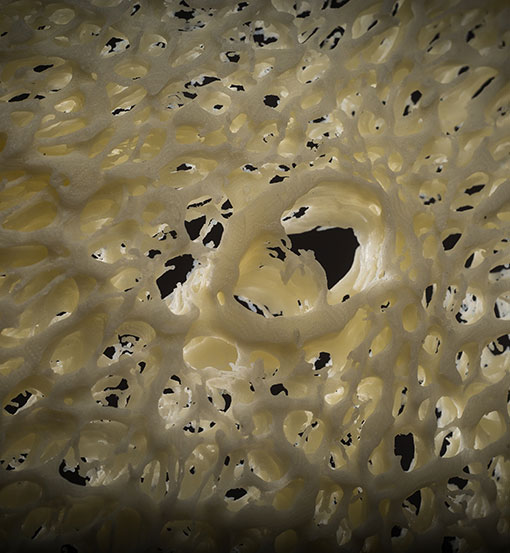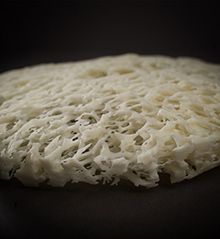Here's Plastic in Your Eye
 The lamina cribrosa, which seals the exit of the optic nerve from the eye, could be a key to the mystery of glaucoma. UAB ophthalmology researcher Crawford Downs designed a device that created the first high-res computer rendering of the tiny structure. Downs was able to turn that image into reality at the 3D Print Lab.
The lamina cribrosa, which seals the exit of the optic nerve from the eye, could be a key to the mystery of glaucoma. UAB ophthalmology researcher Crawford Downs designed a device that created the first high-res computer rendering of the tiny structure. Downs was able to turn that image into reality at the 3D Print Lab.
Crawford Downs, Ph.D., has spent his entire career studying the optic nerve head, but he never really saw it until a few months ago. Using an ingenious system of his own design, Downs had created the first high-resolution computer model of the lamina cribrosa, a mesh-like structure at the back of the eye that allows the optic nerve axons to exit while preserving intraocular pressure. Researchers have long suspected that the lamina cribrosa plays a key role in glaucoma, the second leading cause of blindness in the developed world. “We think it is a mechanical engineering problem,” Downs says. “The eye is like a basketball, under pressure, and elevated intraocular pressure is associated with the damage to the optic nerve we see in glaucoma.”
After meeting Kenneth Sloan at a recruiting dinner—Sloan’s wife, Christine Curcio, Ph.D., is, like Downs, a researcher in the UAB Department of Ophthalmology—Downs embarked on what he calls a “beautiful collaboration.” UAB’s 3D printers reproduced an exact model of the 1.6-mm-wide lamina cribrosa — in a version eight inches in diameter.
“Something you can hold in your hand is a powerful tool,” Downs says. “You can pick it up, twist it around in space, viewing it from different angles. You start to understand how complicated the structure is, and that leads to this hypothesis-forming cascade—it really is a great aid to research.”
 The 8-inch printed version of the 1.6-mm lamina cribrosa has several uses, Downs says. It is an ideal research and teaching tool; it has also proven helpful in fund raising.The 3D-printed model has two other key benefits, Downs adds. “It’s great for teaching—you can pass it around at a meeting,” he explains. “Most researchers don’t understand how complicated the lamina cribrosa is because they’ve only seen it in two dimensions. The model really opens their eyes to the complexities we’re dealing with.”
The 8-inch printed version of the 1.6-mm lamina cribrosa has several uses, Downs says. It is an ideal research and teaching tool; it has also proven helpful in fund raising.The 3D-printed model has two other key benefits, Downs adds. “It’s great for teaching—you can pass it around at a meeting,” he explains. “Most researchers don’t understand how complicated the lamina cribrosa is because they’ve only seen it in two dimensions. The model really opens their eyes to the complexities we’re dealing with.”
The plastic lamina cribrosa also helps in fund raising, a vital component of any large research program. “You can carry one in your briefcase when you are meeting with donors,” Downs says. “This is science you can hold in your hand, which you can’t say of most research. It’s a powerful message to show potential donors what we are doing.”